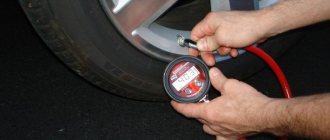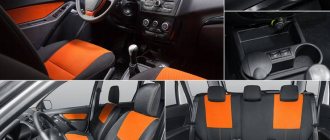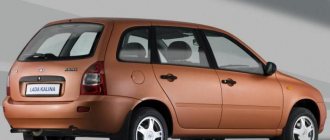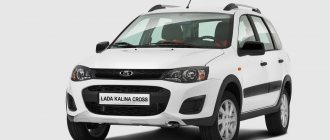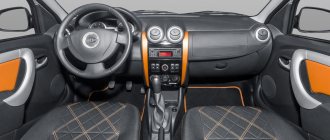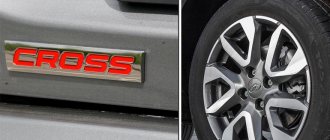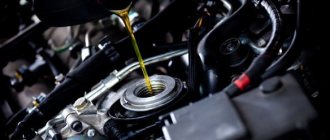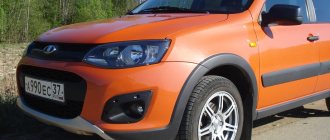Elite
Veteran
Advanced user
ALBEA, half the forum is already intrigued - when will you buy K2?
Brevity is the sister of talent: KoSTbIL. Konstantin. 23 years old. St. Petersburg Information technology engineer. I'm interested in automotive hardware. I'm not afraid of bodywork repairs and anticorrosives. The car is in the signature.
Konstantin. 23 years old. St. Petersburg Information technology engineer. I'm interested in automotive hardware. I'm not afraid of bodywork repairs and anticorrosives. The car is in the signature.
Advanced user
KoSTbIL, yeah, and after 8 years the car has probably gotten tired and the saffron milk caps have gone. After all, in St. Petersburg there is still that kind of humidity that is just right for metal to bloom. I read about the Albea crash test and they didn’t respond very well to the car; the body didn’t pass the torsion test
Elite
Elite
Elite
Advanced user
Alexander, 24 years old, Krasnoyarsk Territory, Belaya Glina village, I work in agriculture as a machine operator. I understand a little about technology. There are no obvious hobbies because there is no time to engage in them. something like this!
Advanced user
Veteran
Alexander, 24 years old, Krasnoyarsk Territory, Belaya Glina village, I work in agriculture as a machine operator. I understand a little about technology. There are no obvious hobbies because there is no time to engage in them. something like this!
Advanced user
Well, you can arrange a test... but what will it look like? A new internal combustion engine versus one that has already driven hundreds of miles?
Elite
**** 2002 Fiat Albea 13.5 from 0-100 km/h 1.4 liters/77 hp 162 max.
Elite
Beginning
Veteran
Elite
Andrey, 25 years old from Tolyatti, painter at AvtoVAZ!
Advanced user
**** 2002 Fiat Albea 13.5 from 0-100 km/h 1.4 liters/77 hp 162 max.
Sitting with a stopwatch, I counted 12.5-13.1
Elite
[td]Go to the forum:
To take part in the discussion you need to log in or register on the site.
Which is better Fiat Alba or Lada Kalina
I'm faced with a choice between Kalina6 and FIAT Albea 1.4 comfort .
Initially I was targeting the viburnum and the station wagon. Having saved up some money, I went to showrooms in Moscow and realized that the car I needed (Kalina6, Riesling color, 2009, without additional equipment) was not available, in principle, there were no colors at all. What the hell is this? Everywhere they say that VAZ warehouses are overstocked, but there are no cars in showrooms. My brother took me to see the Fiat; he himself switched from the Volga to a new Focus and believes that any foreign car is better than the Kalina. In principle, I liked the Albea, although it’s a sedan, it has a large trunk and folding rear seats. The price of a viburnum is 319,000 rubles, the price of a fiat is 409,000 rubles. The difference is noticeable, but the relatives promised to help as long as it wasn’t a VAZ. I’ll say right away that I’ve only driven the Volga, I don’t have much experience, so I think that even a test drive of the car won’t really clarify the situation for me. A car is needed for trips around Moscow and the Moscow region and sometimes for trips into nature; in winter, the car must fit alpine skis and a snowboard.
Since the crisis is sweeping the world and everything is becoming more expensive every day, I want to buy a car as soon as possible. I read on the Internet that VAZ will again raise prices by 3.2% in April. Fiat has already risen in price by 30,000 rubles. Since Kalin is out of stock, I thought about buying a Fiat.
Now about the pros and cons of cars in my opinion!
FIAT Albea 1.4 comfort compared to Kalina6 - overpayment compared to Kalina 90,000 rubles - lack of rear windows (according to the salon managers, it is impossible to install, the doors are too narrow, the mechanisms do not fit) - stamped wheels (fixable) - lack of heated mirrors - lack heated seats (you can buy a separate warmer) - the engine compartment from below is not closed, dirt flies - weak engine, 77 hp. (this engine bothers me a lot) - expensive spare parts - little information about the reliability of the car, you don’t know what to expect - Russian assembly ___________________________________________________ __________ + More ground clearance than any car I know (not jeeps) + presence of rear headrests + interior design, in my opinion , much more decent than that of the viburnum + Speeds are switched without problems (in all the viburnums that I looked at, the speeds were changed badly) + driver's seat height adjustment + opening the gas tank flap from the passenger compartment + assembly, although Russian, but not VAZ
I ask knowledgeable people to help with advice! Maybe there are owners of both cars at once? What's scary about a Fiat is the weak engine and the uncertainty regarding build quality. Is it worth overpaying 90,000 rubles? How much worse (if worse) are the dynamic characteristics of the Fiat compared to the Kalina?
Source
A good way to save: is it worth buying a Fiat Albea for 300 thousand rubles
A sure way to save money when buying a used car is to choose an unpopular model. If you need a large crossover, you can buy the Hyundai ix55 instead of the Toyota Highlander. If something smaller would do, you could look at the Renault Koleos instead of the Nissan X-Trail. But it will be much more difficult if you need the cheapest possible car: after all, it is extremely difficult to find a good Solaris, despite the widest choice, and the prices are no longer as affordable as before. And well-preserved domestic cars do not stay on sale at all; some Lada Kalina can change owner in just a few hours. But cars that have not been tried by our customers stay on sale longer, so here you can choose more thoughtfully and bargain more boldly. One of the clear examples is the Fiat Albea, which at one time did not make an impression on the market and is now forgotten by many. As a result, the cheapest offers start at 130-150 thousand, and the best copies cost less than 400 thousand, which gives hope to bargain for a really good option for a little over 300 thousand. Maybe the model was ignored in vain?
What do you think, which Fiat car has become the most popular in our secondary market? The Compact 500 immediately comes to mind, but this is not it. Maybe Punto? Not again. In fact, it is Albea, which, thanks to its low price and “foreign-brand status” at the start of sales, was able to gain some weight in the market, but then quickly faded away. The model came to us in the mid-2000s, and immediately under localization conditions: at the very end of 2006, assembly started at the Severstal-Auto enterprise. The plans were ambitious: a cheap sedan, with roots going back to the early 80s, played in the budget league, being slightly more expensive than the Renault Logan, and big bets were placed on it. For 315-370 thousand rubles, the buyer received a car with acceptable passive safety, a basic set of active safety equipment in the form of a pair of airbags and ABS, as well as air conditioning and power steering. At the start and in the first years, production was organized from vehicle kits imported from Turkey, and then localization had to deepen, right down to welding and painting the body. However, buyers quickly became tired of the cheap but simple dish made from not the freshest ingredients: if in the fat year of 2008 about 17 thousand cars were sold, then in 2009 - less than 5 thousand, and then the market share of the model did not grow. As a result, by the beginning of the 2010s, the real prospects for localization were virtually reduced to zero, and instead of expanding production, the Italians decided to completely curtail it. However, taking into account the good starting sales, the secondary market for the model can be considered mature: at the time of writing, there were about 400 cars for sale on Avito. Let's see if it makes sense to buy them.
Fiat Albea 2002–11
One of the most important features of the body of a middle-aged budget car is the presence of galvanization, and here the Italians did not disappoint: Albea has it. The layout is quite typical even by today's standards: all external panels except the roof are galvanized. This allows most cars to maintain a decent appearance even despite the owners' modest investments in its maintenance. Perforation corrosion is very rare, unless the car has been handicraft restored after a serious accident. Well, the main spots of rust are quite typical.
The first to give in are the edges of the arches, the hood and the front edge of the roof, which rusts faster than anything else. The sills are covered with plastic moldings, but under them there is also a non-zero chance of finding problem points, at least in the sandblasting zone behind the front wheels and at the attachment points of the trim. The trunk lid traditionally “pleases” with rust in the license plate niche, under the upper plastic molding, as well as on the lower edge at the junction with the bumper. On the most neglected cars, the doors can be upsetting: while sagging hinges, at least on the driver’s side, are more of a norm, then corrosion, even through corrosion, on the lower edges is a sign of poor care. The bottom should be inspected first of all for physical damage: it is decently protected, but where the anti-corrosion has been stripped off, serious problems are possible. Well, it’s also better to inspect the attachment points of the front subframe and suspensions in order to assess the difficulties of future maintenance.
Fiat Albea 2002–11
An inexperienced owner may be a little shocked by the cost of original spare parts. For example, an original front bumper is not only difficult to find, but also costs more than 40 thousand rubles. The rear bumper is almost 30 thousand more, and for the six-figure cost of the hood you can buy another car for spare parts. But here, fortunately, third-party manufacturers come to the rescue. For example, non-original bumpers can be bought for 5-8 thousand, a hood for 10-15, and front fenders for 5-7 thousand instead of 15-18. The original headlight, even though it’s a simple halogen one, costs about 30 thousand, but there are plenty of replacements, and they fit into 5-8 thousand. Well, you can also buy a windshield for 6-8 thousand instead of 40-50. In general, don’t be afraid that restoring this “Italian” after a slight blow will be as expensive as some Alfa Romeo Brera.
As we already know, structurally the Albea is a very old car, so you can’t expect any surprises in the chassis here: a regular MacPherson strut in front and a beam in the rear. The prices for original parts here are sometimes also absurd, so you can ignore them. In general, the chassis is largely unified with other models of the company, such as the related Palio and the not very related Doblo, so the range of non-originals is wide, and the prices are very affordable. For example, a front L-shaped lever assembly can be bought for 2-4 thousand, its rear silent block for 500-900 rubles, and a decent wheel bearing for 1-2 thousand. Maintainability is also high: the front ball joint can be replaced separately, paying less than a thousand rubles for the part. Of course, there is a scattering of cheap silent blocks on sale, and small consumables like stabilizer struts are almost cheaper than VAZ ones. In general, unless you buy a frankly finished car, you will have to invest very moderately in the chassis. By the way, “economists” also love Albea for its wheels with the VAZ 4x98 bolt pattern, which allows you to choose something cheap that suits the offset.
Fiat Albea 2002–11
The braking system is also absolutely predictable and budget-friendly, with disc mechanisms in front and drums in the rear. Reliability is decent, maintainability is good, and maintenance costs are low. Of course, for original brake discs with a modest diameter of 257 mm they ask for more than 10 thousand rubles, but non-original ones can be bought literally an order of magnitude cheaper. Drums are also not as expensive as pads, and all this sometimes provokes owners to save as much as possible. So, based on the condition of the lines, hoses and calipers, it is worth assessing how the brakes were looked after, and not being fooled by stories about new discs or pads. The steering should also be assessed comprehensively: the absence of leaks, intact tips and rods, as well as the absence of knocks and play can be considered a good result. However, these problems are also just a reason for bargaining; there is nothing expensive here. In extreme cases, a restored rack can be bought for 17-20 thousand, a new power steering pump for 4-6 thousand, and consumables are not even worth mentioning. In addition, the resource of the rack, provided that the oil is changed at least once every 50 thousand, may well be 150-200 thousand kilometers.
Albea did not have any choice of gearbox; only a five-speed manual was offered for it. However, this is the only drawback; the box itself rarely causes any complaints, and they are associated with age, wear and sometimes lack of attention. Leaks here occur frequently, so it is worth keeping the seals dry so as not to leave the box without oil. The oil itself should be changed at least once every 50-60 thousand kilometers for the gearbox to go through its 250-300 thousand. Now the chances of encountering a howling box are high, but even this option need not be frightened. Bearing sets have been selected a long time ago, synchronizers are also available, so it’s enough to bargain for 15-20 thousand rubles for repairs. A clutch kit with a release bearing can be bought for 4-6 thousand, which is extremely inexpensive (while the original costs about 20 thousand). It’s just that it’s easier to find a flywheel at a disassembly site for next to nothing than to pay 25-30 thousand for a new piece of metal.
Fiat Albea 2002–11
The Italian state employee also had one engine, and it was also middle-aged and modest. The Fire series unit, which appeared in the mid-80s, has a 1.4 liter volume, a cast iron block and only 2 valves per cylinder, which gives an output of 77 horsepower. The only “technical trick” is the phase regulator at the inlet; otherwise the technology is as primitive as possible. The timing drive is belt driven, and lovers of maximum savings, in addition to the low cost of replacement, will also be pleased with the fact that it does not bend the valve if the belt breaks. In terms of service life, the engine is predictably excellent: if you monitor cooling, prevent leaks and loss of oil level, and also clean the crankcase ventilation system, then it can travel 300-350 thousand kilometers or more. True, you should not believe the Italian regulations, which require changing the oil every 15 thousand kilometers. Of course, it is unlikely to find a standard catalyst on a car now, but if it has been preserved, you need to remember about possible problems due to its destruction. Even though this engine can be “recapitalized” quite inexpensively, no one will want to do it ahead of schedule.
Fiat Albea 2002–11
So, now it becomes clear that Albea is a completely worthy ideological heir to the “kopecks” localized in the USSR and others like them. The machine is structurally old, very simple and very inexpensive to maintain. At the same time, it has practically no obvious shortcomings, except for one global one - the overall budgetary implementation. The basic Albea with one airbag, without ABS, power windows and air conditioning is an outdated car by today's standards, to put it mildly. However, for a little over 300 thousand you can look for a car in higher trim levels, which will have a second front airbag and other options. Moreover, despite being at least 9 years old, you can still find a decent car from the first owner - for example, this one. However, even when buying a car for 300 thousand, you should not skimp on checking its history: for example, Autotek will tell you not only about accidents, mileage and number of owners, but also about deposits, restrictions and other pitfalls. And if there are none, you can drive a Fiat Albea until you get tired of it, spending no more on maintenance than on a domestic car. And in the future, maybe the love for Italian cars will lead to Alfa Romeo.
Cheap “Tatar Kalina” Fiat Albea (for 180 thousand rubles)
Good afternoon! Today my neighbor bought an old Fiat Albea, 2008, for a very ridiculous price of 180 rubles. According to the title, he turned out to be the third owner, but the mileage on the dashboard showed almost 105 t.km. I don’t know, honestly, I don’t know, time will tell of course. But the little man glowed with the joy of his purchase like a street lamp. Before the Fiat, he had an old 15-year-old seven. After my congratulations, I began to examine the car, I became interested, it was a ten-year-old foreign car and for such a ridiculous price, I was left in a mystery.
In appearance, the car looks good, original, and against the background of GAZ and LOGAN it looks even better. Yes, it has small dents and abrasions, but still, in my opinion, the body is preserved in its original paint. In my opinion, I can’t call the paintwork durable - it scratches quite well, but galvanization decides the main thing, there is no rust at all. So the car shouldn't rot.
A fairly high ground clearance of 160 mm, it seems to me that this car is enough to avoid landing on the bottom in the spring mud, and in winter to drive on almost any track (within reason, of course). The front part of the car, in principle, like the rear part, looks modest, I would say for the taste and for an amateur. After an external inspection, I got behind the wheel and drove a couple of blocks around my favorite city, of course with a happy owner. What can I say, the brakes are really very good, sharp, fairly short pedal but easily predictable. In my opinion, the engine is frankly weak for the highway; the shortened gearbox performs well in the city. Quite fast acceleration to hundreds further, let's say not very fast. There is windage, but it interferes.
According to reviews, I read that the Fiat Albea engine consumes no more than the stated 1 liter of oil per 10,000 km. I don’t know how this car will perform, time will tell. The dynamics in city traffic are enough for quick maneuvering, 4th gear has a lot of traction, it pulls confidently from 40 km/h, and 5th gear from 55 km/h. On the highway you need to get used to the car, just like any car, of course. But overall the car handles great, it takes a little time to get used to the windage of heavy trucks. Engine noise becomes intrusive only after 140 km/h. (also from reviews of the car), time will tell how it turns out in real life. Consumption in the city during intensive driving, according to the owner of the car, is no more than 8 liters, at quiet 6.5-7 liters, on the highway at 90 km/h - 5 liters, 150 km/h - the same 8 liters as in city.
Source
Review of Fiat Albea 1.4 (2008)
I have a 2008 Albaea, purchased in February 2012.
Before the Alba there was a Kalina luxury sedan 2008, a Nissan Tiida 2008. and Volkswagen Polo automatic 2002. Cars are of different classes, so I can only roughly compare them with the Kalina. I bought a Fiat with 47,000 mileage from a friend. Over the course of a year, I clocked up about 24 thousand, changed the oil a couple of times, adding about a liter from replacement to replacement, and the low beam lamps. Closer to winter, there was a creaking in the lane area. left rack. I did an inspection and it turned out that in the spring I would have to change the struts all around, the rear springs, and the hubs with bearings. It was my own fault with the hubs; when changing wheels for winter, I screwed them in with casting bolts, thereby killing the threads in the hubs. I decided not to take risks with cutting a new one and replace the hubs, and the bearings are still alive, but they will have to be replaced automatically with the hubs. I drove through the winter at my own risk and did nothing. In March I had a good ride through puddles and the generator bearing began to hum. Now I have started to repair it. I read reviews about the price of spare parts and their absence from catalogues, and prepared for the worst. But surfing the forums confirmed a simple truth: He who seeks will always find. I found the spare parts codes and calmly selected analogues using them. Their prices surprised me:
- Wheel bearing Italy: 410 rub. (Suitable from Kalina, price 750 rubles!!!)
- Hub: 500 rub.
- SKF generator bearing, good price range, depends on the supplier, availability in the warehouse and delivery time from 200 - 800 rubles, I took both for 350 rubles.
- The front struts are softer than the original, the car drives much smoother - 2500 each.
- Rear Türkiye, 1300 per piece. and reinforced rear springs for 800 rubles.
- Lever silent block - 200 rubles.
So far there are no problems with the steering wheel, gearbox and engine.
At the moment, based on the chassis, I concluded, comparing with Kalina, that servicing a Fiat is cheaper, taking into account the fact that many analogues are almost half the price of VAZ spare parts.
And if you consider that I had a track record on Kalina for the same mileage:
1) Replacement of the Radiator - 2 times (1st time under warranty, a year after purchase, it was rotten).
2) Replacement of all racks and supports at 45 thousand km.
3) Replacement of the generator.
4) Replacing the speed sensor..
5) Replacement of the Throttle Position Sensor.
6) Replacement of ball, steering tips and wheel bearings.
7) Replacement of the steering rack, because it cannot be repaired.
 Replacing the trapezoid wipers.
Replacing the trapezoid wipers.
9) Replacement of both rear electric windows.
10) Replacement of the Battery.
And a bunch of other little things, diagnostics, etc., because of which I had to go to a service station at least once a month and leave there from 500 to 1500 rubles, and besides, there were eternal incurable diseases, such as oil consumption liter per 1000 km (at the service they shrugged their shoulders and said that this is how it should be), there is always antifreeze leaking out into unknown places. Gentlemen, I have something to compare with. For me, going through my time and nerves is much more expensive. I'm not comparing to Logan or some abstract mythical machine that "Doesn't break down." Everything breaks. The only question is how often and how expensive and difficult it is to fix it.

